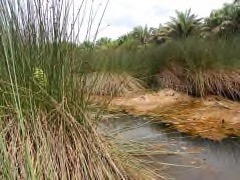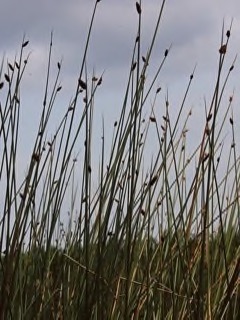 |
|
wikimedia.org Wibowo Djatmiko (Wie146) |
 |
| wikimedia.org Wibowo Djatmiko (Wie146) |
Translate this page:
Summary
Physical Characteristics

 Lepironia articulata is an evergreen Perennial growing to 1.5 m (5ft) by 0.1 m (0ft 4in) at a fast rate.
Lepironia articulata is an evergreen Perennial growing to 1.5 m (5ft) by 0.1 m (0ft 4in) at a fast rate.
See above for USDA hardiness. It is hardy to UK zone 10. The flowers are pollinated by Wind, Insects.
Suitable for: light (sandy), medium (loamy) and heavy (clay) soils. Suitable pH: mildly acid and neutral soils and can grow in very acid and saline soils.
It can grow in semi-shade (light woodland) or no shade. It prefers moist or wet soil and can grow in water.
UK Hardiness Map
US Hardiness Map
Synonyms
Chondrachne articulata (Retz.) R.Br. Choricarpha aphylla Boeckeler Lepironia compressa Boeckeler Lepironia conifera (Poir.) Druce Lepironia mucronata Rich. ex Pers. Restio articulates Retz. Scirpus coniferus Poir.
Plant Habitats
Edible Uses
References More on Edible Uses
Medicinal Uses
Plants For A Future can not take any responsibility for any adverse effects from the use of plants. Always seek advice from a professional before using a plant medicinally.
None known
References More on Medicinal Uses
The Bookshop: Edible Plant Books
Our Latest books on Perennial Plants For Food Forests and Permaculture Gardens in paperback or digital formats.

Edible Tropical Plants
Food Forest Plants for Hotter Conditions: 250+ Plants For Tropical Food Forests & Permaculture Gardens.
More

Edible Temperate Plants
Plants for Your Food Forest: 500 Plants for Temperate Food Forests & Permaculture Gardens.
More

More Books
PFAF have eight books available in paperback and digital formats. Browse the shop for more information.
Shop Now
Other Uses
The leaves are used for basket making, weaving into mats for packing items such as kapok, cotton, rubber etc[46 ]. Highly ornamental with potential as a designer water feature plant.
Special Uses
Carbon Farming
References More on Other Uses
Cultivation details
Management: Hay Regional Crop
It grows in ephemeral swamps and the margins of fresh water swamps. It often occurs in acid sulfate soils. Grows in full sun to 50% shade in ephemeral swamps and the margins of fresh water swamps in water 0—500mm deep. Lepironia is native to the Central Coast, Mid & North Coast and coastal Queensland, Australia. While it is naturally restricted to the coast it will grow in inland climates if protected from heavy frost.
Carbon Farming
-
Management: Hay
Cut to the ground and harvested annually. Non-destructive management systems maintaining the soil organic carbon.
-
Regional Crop
These crops have been domesticated and cultivated regionally but have not been adopted elsewhere and are typically not traded globally, Examples in this broad category include perennial cottons and many nuts and staple fruits.
References Carbon Farming Information and Carbon Sequestration Information
Temperature Converter
Type a value in the Celsius field to convert the value to Fahrenheit:
Fahrenheit:
The PFAF Bookshop
Plants For A Future have a number of books available in paperback and digital form. Book titles include Edible Plants, Edible Perennials, Edible Trees,Edible Shrubs, Woodland Gardening, and Temperate Food Forest Plants. Our new book is Food Forest Plants For Hotter Conditions (Tropical and Sub-Tropical).
Shop Now
Plant Propagation
Seed
Other Names
If available other names are mentioned here
Purun, Purun danau
Native Range
TEMPERATE ASIA: China (Guangdong Sheng, Hainan Sheng), Japan (Ryukyu Islands), Taiwan TROPICAL ASIA: India, Sri Lanka, Indonesia (Papua), Papua New Guinea, Cambodia, Laos, Thailand, Vietnam, Indonesia (Kalimantan, Sulawesi, Maluku, Sumatera), Malaysia PACIFIC: Micronesia, Fiji, New Caledonia, Tonga AUSTRALASIA: Australia (New South Wales (east), Queensland, Northern Territory) AFRICA: Madagascar
Weed Potential
Right plant wrong place. We are currently updating this section.
Please note that a plant may be invasive in one area but may not in your area so it's worth checking.
None Known
Conservation Status
IUCN Red List of Threatened Plants Status : This taxon has not yet been assessed

Growth: S = slow M = medium F = fast. Soil: L = light (sandy) M = medium H = heavy (clay). pH: A = acid N = neutral B = basic (alkaline). Shade: F = full shade S = semi-shade N = no shade. Moisture: D = dry M = Moist We = wet Wa = water.
Now available:
Food Forest Plants for Mediterranean Conditions
350+ Perennial Plants For Mediterranean and Drier Food Forests and Permaculture Gardens.
[Paperback and eBook]
This is the third in Plants For A Future's series of plant guides for food forests tailored to
specific climate zones. Following volumes on temperate and tropical ecosystems, this book focuses
on species suited to Mediterranean conditions—regions with hot, dry summers and cool, wet winters,
often facing the added challenge of climate change.
Read More
Expert comment
Author
(Retz.) Domin
Botanical References
Links / References
For a list of references used on this page please go here
A special thanks to Ken Fern for some of the information used on this page.
Readers comment
| Add a comment |
|
If you have important information about this plant that may help other users please add a comment or link below. Only comments or links that are felt to be directly relevant to a plant will be included. If you think a comment/link or information contained on this page is inaccurate or misleading we would welcome your feedback at [email protected]. If you have questions about a plant please use the Forum on this website as we do not have the resources to answer questions ourselves.
* Please note: the comments by website users are not necessarily those held by PFAF and may give misleading or inaccurate information.
To leave a comment please Register or login here All comments need to be approved so will not appear immediately.
|
Subject : Lepironia articulata
|
|
|
|